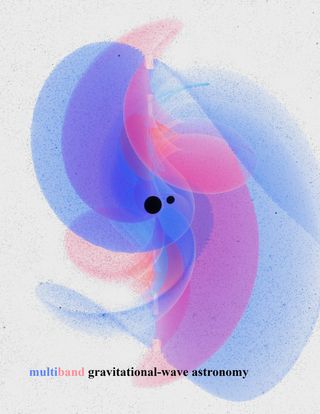Black holes are among the most fascinating objects in the universe, yet they remain elusive because they are so incredibly dense, and their gravity is so strong that not even light can escape their grasp. To uncover black holes hiding across the cosmos, researchers have turned to an emerging field of research known as gravitational-wave astronomy.
Gravitational waves are distortions, or ripples, in the fabric of space and time produced by the movement of massive objects. In 2015, astronomers detected the motion of gravitational waves for the first time using the telescopes of the Earth-based Laser Interferometer Gravitational-Wave Observatory (LIGO) in Louisiana and Washington. In this case, the ripples were produced by a violent collision of two massive, co-orbiting black holes known as a black hole binary.
Using LIGO and other observation technologies, a new study aims to paint a more complete picture of black holes — specifically those belonging to the more obscure category known as intermediate-mass black holes (IMBHs).
Related: 9 Ideas About Black Holes That Will Blow Your Mind
"When I joined LIGO, I realized that my years of general relativistic simulation of black holes can be brought in to develop a new astrophysical hunt of IMBHs," Karan Jani, an astrophysicist from Vanderbilt University and lead author of the study, told Space.com
IMBHs fall somewhere between supermassive — at least a million times greater than our sun — and stellar-mass black holes — smaller, but still five to 50 times greater than the mass of our sun.
"IMBHs are very special in the inaugural decade of gravitational-wave astronomy. Among every known astrophysical source that emits gravitational waves, we report that both LIGO and LISA [Laser Interferometer Space Antenna] are most sensitive to mergers of IMBHs," Jani said. "With these two experiments, we can practically survey all the IMBH binaries in the universe."
However, astronomers have not yet been able to directly detect these elusive, medium-size black holes, Jani added. Thus, his approach is to study the different frequencies of gravitational waves emitted by black holes to gain a better understanding of IMBH activity.

"Like a symphony orchestra emits sound across an array of frequencies, the gravitational waves emitted by black holes occur at different frequencies and times," Jani said in a statement from Vanderbilt University. "Some of these frequencies are extremely high-bandwidth, while some are low-bandwidth, and our goal in the next era of gravitational wave astronomy is to capture multiband observations of both of these frequencies in order to 'hear the entire song,' as it were, when it comes to black holes."
IMBHs are believed to be the seeds from which supermassive black holes grow. For example, black holes may grow by gobbling up other black holes. In the region of infalling matter surrounding a black hole, also known as the accretion disk, strong gravitational forces pull in nearby gas, stars, dust and even other black holes. Any material that gets too close risks being drawn past the event horizon — the point beyond which it can't escape the black hole's gravitational pull.
"As soon an IMBH has trapped another black hole in its vicinity, there will be a flurry of gravitational radiation," Jani told Space.com. "LIGO can catch this radiation at the instance these black holes collide."
The proposed LISA mission — jointly led by the European Space Agency and NASA — will be able to detect and accurately measure low-frequency gravitational waves, which is challenging for Earth-based detectors, due to our planet's seismic motion or even vibrations from a passing car. Planned to launch in 2034, LISA would be the first dedicated space-based gravitational-wave detector.
"With the LISA mission, our study finds that radiation from IMBHs can be recorded at least a few years before their fateful collision," Jani said. "This radiation is literally the space-time being deformed right outside the event horizon of the IMBHs. Unlike a radio or X-ray signal, the gravitational radiation does not lose information as it travels billions of light-years before reaching us."
Therefore, by combining observations from LIGO detectors, which capture high-frequency gravitational waves, and future detectors such as the LISA mission, which will measure low-frequency gravitational waves, the researchers hope to fill in gaps in the current understanding of black holes.
Their study was published Nov. 18 in the journal Nature Astronomy.
Follow Samantha Mathewson @Sam_Ashley13. Follow us on Twitter @Spacedotcom and on Facebook.

"space" - Google News
November 27, 2019 at 11:00PM
https://ift.tt/2QS5Q8R
Astronomers Will Use Gravitational Waves to Observe a 'Black Hole Symphony' - Space.com
"space" - Google News
https://ift.tt/2Q8TIzF
Shoes Man Tutorial
Pos News Update
Meme Update
Korean Entertainment News
Japan News Update
Bagikan Berita Ini

















0 Response to "Astronomers Will Use Gravitational Waves to Observe a 'Black Hole Symphony' - Space.com"
Post a Comment